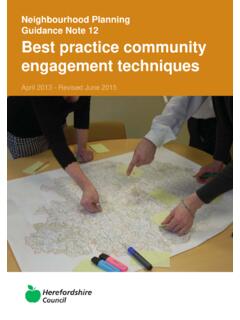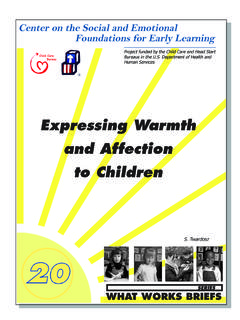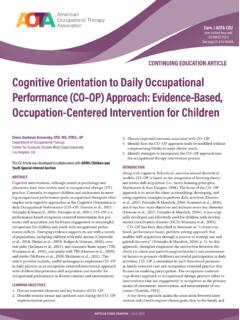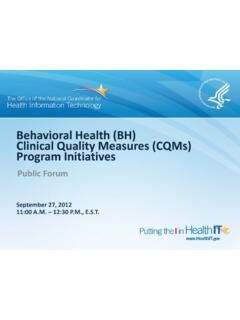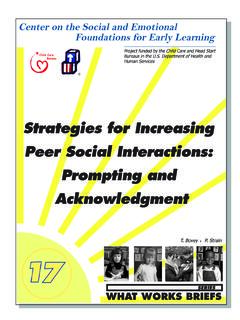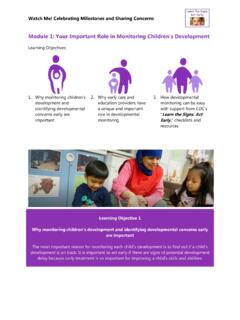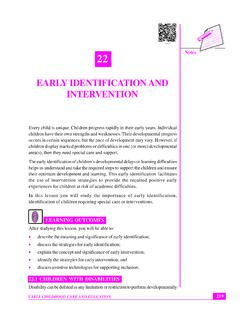Transcription of Intervention guidance for Special Educational Needs and ...
1 guidance for Special Educational Needs and Disabilities (SEND) in Schools and other Educational settingsThis guidance aims to help schools and other Educational settings in Herefordshire meet the Needs of children and young people (CYP) with SEND. It should be used as a reference to guide and inform practice and to plan individual Educational programmes for children with SEND. The document uses the categories of need and outlines the staged or graduated process of Intervention described in the SEND Code of Practice (2014; ). It identifies the teaching and learning strategies and types of approaches useful for promoting and supporting SEND. It provides examples of the degree of support expected at each level and outlines the plan-do-review approach to assessment, Intervention and review for CYP with SEND.
2 This model is consistent with the three waves of Intervention outlined by in the National Strategies and the rest of this document provides examples of what can be done by schools at each wave of Intervention (universal, targeted and specialist). In Herefordshire we have outlined four levels of need, which require an increasingly targeted and specialist degree of support and Intervention . These levels are described on the next Approach in Herefordshire: 4 levels of response 2 Communication and Interaction 4 Cognition and Learning 16 Social, Emotional and Mental Health 25 Physical and Medical 36 Hearing Impairment - HI 45 Visual Impairment - VI 56 Multisensory Impairment/Deaf blindness 64 ContentsPageThe Graduated Approach to SEND in HerefordshireThis graduated approach ensures that children with Special Educational Needs and disabilities (SEND) get the right level of support when needed.
3 This document outlines the levels that children and young people (CYP) and their families may go through in this process. Not every child will need to progress through all these levels, and only those with the most complex Needs require an Education and Health Care Plan. Most pupils and students will receive early Intervention and will have their Needs identified and met by their school without the need for further input. Schools should apply an assess, plan-do-review approach to meeting children s 1 - For all pupilsNearly all children will have their Needs met by teaching or support that is available to all children in a school. This could include extra time and support from their teacher or some other form of help planned to ensure a child makes expected progress with their education.
4 The Local Offer in each school outlines the kinds of support and help that is available at this level of need. One way to ensure that progress is made is by completing a profile of the child s strengths and difficulties which also includes a plan for what will be needed for them to make progress. Level 2 School Individual PlanIndividual Plan: If the Needs and difficulties noted at Level 1 and outlined in the child s profile persist, they will require a greater level of attention and support. This requires that the school produce an individual plan for the child which sets out in small steps how the child s Needs will be met (sometimes called an individual education plan/IEP).
5 This will include the results of assessments made of the child s strengths, difficulties and progress, and identify targets and measures that should be put in place to meet these Needs . This plan will need to be discussed with parents and then reviewed after a period of Intervention (termly). If it has worked the plan can be ended. If not, the review should identify what further help is needed. The school must decide with parents how often a plan should be reviewed and what increasing levels of support need to be applied before moving to the next level. This type of school Intervention plan should not be confused with an EHC plan (see level 4 on page four). Level 3 School Plan Plus Plan Plus : Sometimes the identified Needs of the child or young person (CYP) may require the involvement of a group or team of practitioners/professionals.
6 They may work in different areas such as health, education or social care. These practitioners may contribute further information and assessments and provide useful advice to support the family and school in meeting the child or young person s Needs . The parents/carers and family will be a key part of this process, and child or young person s response to Intervention will be reviewed regularly and at least each term. If working, the Plan Plus can be reduced to a Plan or removed entirely. If it is not working well a review may indicate that moving to Level 4 is 4 Request for a Statutory AssessmentRequest for Education and Health Care (EHC) assessment: If the family and/or school of the CYP believe their Needs are particularly complex, and that further and greater specialist support is required to meet the child s SEND, they should consider the need for a statutory assessment.
7 The school (or sometimes another practitioner) will usually make a request for this assessment by completing a Family Conversation and submitting this to the Council s SEN team. Parents also have the right to make this request. The Family Conversation should contain all of the basic information needed to help the Council decide whether an assessment is necessary. This must include a demonstration that Levels 1 to 3 have been thoroughly completed. The request is then considered by the Council and a multi-agency group of professionals including staff from education, health and social care are asked to provide advice. If the decision is no , then alternative sources of help and support will be signposted.
8 If the decision is yes , then an assessment takes place and the child/young person and their family are invited to tell their stories. If an EHC plan is needed, this will be co-produced with the family and outline their goals and ambitions and the types of support, resources and funding required to ensure these aspirations are Graduated Approach to SEND in HerefordshireCommunication and InteractionBroad Areas of Need5 Universal - All ChildrenAll children need to be able to understand and use language effectively to access the curriculum and communicate with others. children s linguistic competence supports their learning as well as theircommunication children have difficulty inunderstanding others and in expressing themselves.
9 They may have difficulty with speech and or articulation (forming sounds) and using correct sound in words). They may have difficulty in expressing their thoughts and ideas clearly. There may be difficulties in fluency which result in may have difficulty with social interaction, social understanding and lack flexibility in thought and behaviour. They may have difficulties with attention and listening, and any of these weaknesses may mean the child Needs some short-term support. It should not be assumed that they have Special Educational children s communication and interaction difficulties cannot be met by universal approaches over a sustained period of difficulties may interfere with their ability to access the curriculum, and impact negatively on their emotional and mental health, and relationships with with these difficulties may have received a diagnosis, for example, developmental language disorder, or speech and language delay.
10 They may have language difficulties in association with other conditions such as autism. These children will require a graduated approach which draws on increasingly detailed interventions and support approaches, and where appropriate specialist expertise, in successive cycles of assessment, planning, Intervention and review is applied and which ensures interventions match few children s difficulties are severe and longstanding and have not responded to focussed and well-founded interventions over a period of time. The severity of their difficulties may have a considerable impact on their ability to access to the range of difficulties these children are experiencing may also be impacting on their emotional and mental health and relationships with children will require a graduated approach which draws on very detailed interventions and support approaches and specialist expertise in successive cyclesof assessment, planning, Intervention and review.
